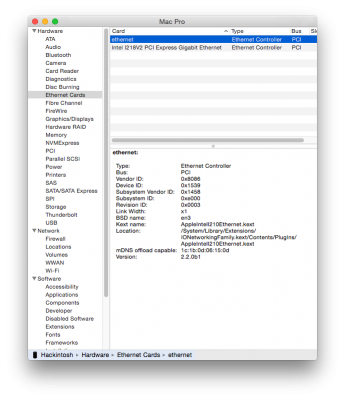+-o D087@0 <class IOPCIDevice, id 0x100000402, registered, matched, active, busy 0 (42 ms), retain 13>
| {
| "acpi-device" = "IOACPIPlatformDevice is not serializable"
| "acpi-path" = "IOACPIPlane:/_SB/PCI0@0/RP06@1c0005/D087@0"
| "assigned-addresses" = <10005682000000000000d0df0000000000000200180056810000000000c0000000000000200000001c005682000000000000d2df0000000000400000>
| "class-code" = <00000200>
| "subsystem-vendor-id" = <58140000>
| "vendor-id" = <86800000>
| "IOPCIExpressLinkCapabilities" = 4348945
| "IOName" = "ethernet"
| "IOPCIPMCSState" = 0
| "IOPCIPauseCompatible" = Yes
| "IOChildIndex" = 1
| "pcidebug" = "86:0:0"
| "IOPCIExpressLinkStatus" = 4113
| "pci-aspm-default" = 0
| "IOPCIExpressCapabilities" = 2
| "IOInterruptControllers" = ("io-apic-0","IOPCIMessagedInterruptController")
| "built-in" = <00>
| "IOPCIResourced" = Yes
| "IODeviceMemory" = (({"address"=3754950656,"length"=131072}),"IOSubMemoryDescriptor is not serializable",({"address"=3755081728,"length"=16384}))
| "IOPowerManagement" = {"ChildrenPowerState"=2,"CurrentPowerState"=2,"CapabilityFlags"=2,"ChildProxyPowerState"=2,"MaxPowerState"=3}
| "acpi-pmcap-offset" = 64
| "name" = <"ethernet">
| "subsystem-id" = <00e00000>
| "RM,device-id" = <33150000>
| "compatible" = <"pci1458,e000","pci8086,1539","pciclass,020000","D087">
| "acpi-wake-type" = 2
| "IOReportLegendPublic" = Yes
| "reg" = <0000560000000000000000000000000000000000100056020000000000000000000000000000020018005601000000000000000000000000200000001c00560200000000000000000000000000400000>
| "IOReportLegend" = ({"IOReportGroupName"="Interrupt Statistics (by index)","IOReportChannels"=((5291294645182070784,5368709121," First Level Interrupt Handler Count"),(5291294645182070785,5368709121," Second Level Interrupt Handler Count"),(5291294645182070786,5368709121," First Level Interrupt Handler Time (MATUs)"),(5291294645182070787,5368709121," Second Level Interrupt Handler CPU Time (MATUs)"),(5291294645182070788,5368709121,"Second Level Interrupt Handler System Time (MATUs)")),"IOReportChannelInfo"={"IOReportChannelUnit"=0},"IOReportSubGroupName"="1"})
| "device-id" = <39150000>
| "revision-id" = <03000000>
| "IOInterruptSpecifiers" = (<1100000007000000>,<0900000000000100>)
| "IOPCIMSIMode" = Yes
| }
|
+-o AppleIntelI210 <class AppleIntelI210, id 0x1000005ff, !registered, !matched, active, busy 0 (0 ms), retain 8>
| +-o en3 <class IOEthernetInterface, id 0x10000063c, registered, matched, active, busy 0 (0 ms), retain 10>
| +-o IONetworkStack <class IONetworkStack, id 0x10000051c, registered, matched, active, busy 0 (0 ms), retain 12>
| +-o IONetworkStackUserClient <class IONetworkStackUserClient, id 0x1000005ea, !registered, !matched, active, busy 0, retain 5>
+-o FakePCIID <class FakePCIID, id 0x100000600, !registered, !matched, active, busy 0, retain 4>


